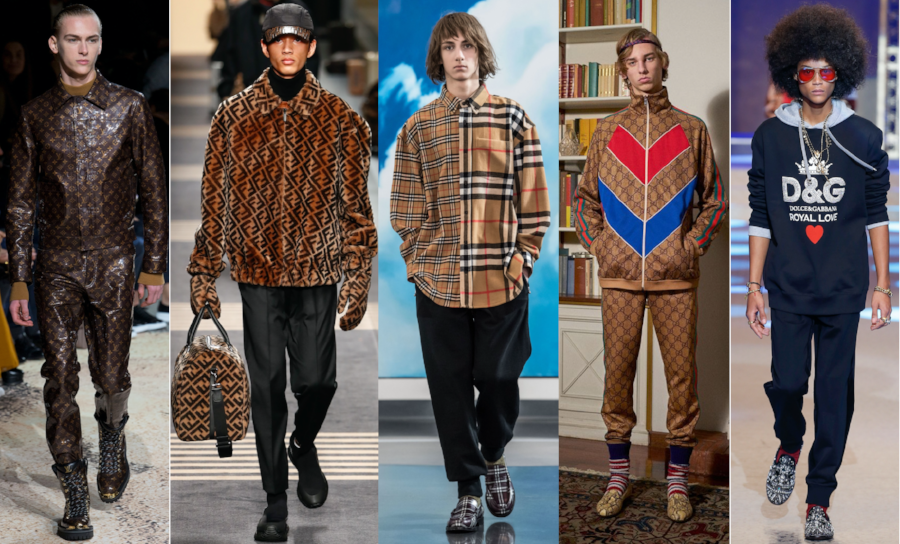
“Fashion is in the midst of a sea change,” wrote Vogue’s Kristin Anderson in 2016. She was referring to the industry’s abandonment of Phoebe Philo-esque minimalism in favor of “estate-sale maximalism,” which, of course, entails the return of logomania. “The Spring/Summer 2016 collections came branded to the hilt, from Loewe and Lanvin to Pucci and Vuitton,” and the logo-driven moment has not waned in the seasons since. “Logomania’s glorious return” is alive and well in 2018.
Sure, there are cultural and sociological reasons behind the recent resurgence of logos all over the runways, whether it be in the form of logo-covered leggings and trench coats from Kim Jones’ final Louis Vuitton collection or Gucci’s Pre-Fall 2018 collection, which includes track suits with multiple signatures from the Italian design house, such as its interlocking “G” logo and its highly contested (by Forever 21) green-red-green striped trademark.
But there is something else at play here, aside from the trend-worthiness of advertising a brand (and your social standing) on your chest, shoes, or by way of your bag, something that for many brands dates back 100 years … or more: Trademark law.
In the U.S., in particular, protection for fashion designs can be difficult to come by due to the way intellectual property laws are structured. For instance, copyright law does not provide protection for useful articles, such as clothing, in their entirety, and design patents can be relatively costly and entail a bit of a time-consuming process. The lack of ideal protection tends to enable fast fashion retailers and other copycats to thrive, and at the same time, it forces brands to formulate creative ways to ward off copycats.
This is just whatLouis Vuitton did 130 years ago. The world’s most valuable luxury brand, which got its start in 1854, operated for the vast majority of its life as a leather goods company. From the outset, Louis Vuitton was targeted by counterfeiters who wanted to profit from the established appeal of the brand. As a result, Louis Vuitton – the man and his eponymous brand – began exploring ways to legally protect the house’s creations, i.e., its various trunks.
This took the form of the adoption of new monogram canvas designs from which the brand would make its various bags and other travel items. The print, itself, could be protected by law and thus, give rise to a legal cause of action if it was to be copied. One of the earliest designs was Louis Vuitton’s checkered Damier pattern, which when it was first created in the 1888 bore a logo that read “marque L. Vuitton déposée,” which translates to “L. Vuitton registered trademark.”
Another key pattern to come from Louis Vuitton shortly thereafter in 1890’s, was one that featured Mr. Louis Vuitton’s initials against a background of stars and flowers. Sound familiar? It was the brand’s Toile Monogram, which still enjoys expansive legal protection (both copyright and trademark) on a global scale in 2018.
Louis Vuitton knew that if it covered its products – namely its trunks and other travel goods – with these prints, it would make it much more difficult for others to copy them in an accurate way without running afoul of trademark law, thereby turning what might otherwise be an unprotectable object into one with legal protections.
Fast forward to Fall/Winter 2018 and this is exactly what the design house has done with the trench coats it showed via Kate Moss and Naomi Campbell (and no shortage of leggings, the denim trousers and jacket that model Dominik Sadoch wore and so on). By covering the otherwise completely utilitarian (and thus, unprotectable) trench coats with its Toile Monogram print, which is protected globally by a whole handful of trademarks and copyrights, Louis Vuitton can ensure that copyists cannot legally reproduce the coats. If Zara, for instance, were to do that, Louis Vuitton would have a clear cut case for counterfeiting.
The jackets also served as a oberly Instagrammable element for Jones’ finale show.
The same can be said for everything from Fendi’s monogram-covered jackets and Gucci’s logo-laden track suits to Dolce & Gabbana’s “D&G”-covered footwear and Prada’s name-plate ties. In much the same way as Louis Vuitton inserting its protected monogram print into the mix, the addition of these brands’ legally-protected logos will likely help to ward off the more law-abiding copyists – the fast fashion retailers of the world (as distinct, of course, from counterfeiters, who thrive on the illegal recreation of logos).
Interestingly enough, somewhere along the line between the time when Louis Vuitton debuted its monogram canvas and the Instagram age of 2018 when Gucci fans will pay $1,200 for a branded cotton hoodie, logos shifted from being a purely utilitarian anti-counterfeiting device to acting as the easiest visual signifier of what you as a consumer value, and with that shift, these logos have actually become one of the most highly counterfeited elements of any brand’s repertoire. Ironic.











